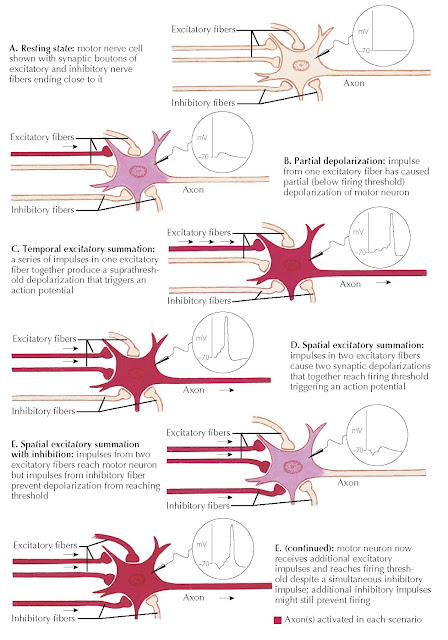SUMMATION OF
EXCITATION AND INHIBITION
Summation of excitation and inhibition is the vital principle on which the functioning of the CNS is based. The illustration shows the various intracellular potential changes observed during temporal and spatial summation of excitation and inhibition, as voltage- versus-time tracings similar to those produced by an oscilloscope.
The principle of summation relates
to the fact that a neuron typically has a large number of synaptic terminals
(boutons) ending upon it; alone, each bouton is capable of producing only a
small synaptic potential. The small excitatory postsynaptic potential (EPSP)
produced by a single excitatory terminal is not sufficient to depolarize the
motor neuron to its threshold point. For suprathreshold depolarization to be
produced, either temporal or spatial summation of excitation must take place.
 |
| Plate 2-16 |
Temporal summation occurs when a burst of action potentials reaches
a nerve fiber terminal. If the terminal is excitatory, the first action
potential in the burst pro- duces a depolarizing EPSP in the motor neuron that
begins to decay toward the resting potential. Before the decay is complete,
another action potential arrives in the terminal and evokes a second EPSP. The
depolarization caused by this EPSP adds to the residual depolarization
remaining from the first EPSP and moves the membrane potential closer to the
threshold level. Finally, the EPSP evoked by a third action potential adds its
depolarization to that produced by the first two to drive the membrane
potential past the threshold level and to trigger an action potential in the
motor neuron. Thus, because of temporal summation, a burst of action potentials
in an excitatory fiber is able to evoke the firing of a target neuron, even
though the individual EPSPs evoked by single action potentials are too small to
produce a suprathreshold depolarization. In a similar manner, the inhibitory
postsynaptic potentials (IPSPs) produced by a burst of action potentials in an
inhibitory fiber can summate to produce a large hyperpolarizing potential.
Spatial summation involves the activation of two or more terminals at approximately the same time.
When such synchronous activation occurs, the inward and outward currents evoked
by excitatory and inhibitory terminals summate to produce a net shift in the
membrane potential of the target cell. If two excitatory terminals are
activated, the net membrane potential shift will be a depolarization approximately
equal to the sum of the EPSPs that would be evoked by each terminal acting
alone; this combined depolarization exceeds the threshold level and triggers an
action potential. If, in addition to the two excitatory terminals, an
inhibitory terminal is also activated, the net depolarization will be reduced
by an outward flow of current at the inhibitory synapse. Under these
conditions, additional excitation is required to produce a suprathreshold
depolarization. Spatial summation plays a vital role in the interaction of
patterns of activity originating in various neuronal pathways. For example, in
the case of the effect of central motor tone on the reflex evoked by muscle
stretch, the stretch produces a volley of action potentials in the group Ia fibers
from the stretched muscle. The synaptic action of the Ia fiber terminals evokes
medium-to-large EPSPs in motor neurons supplying the stretched muscle and small
EPSPs in motor neurons supplying synergistic muscles. If the body is in a
relaxed state, only the motor neurons receiving large EPSPs will discharge action potentials, causing a
small twitch of the stretched muscle; the remaining motor neurons, which
receive EPSPs too small to evoke firing, constitute the subliminal fringe of
the stretch reflex. If the body is in an active state, central nervous pathways
will produce a steady excitatory input to the motor neurons involved in the
stretch reflex. Thus many of the neurons in the subliminal fringe will receive
sufficient additional excitation to cause them to
fire, and muscle stretch may result in a vigorous contraction of that muscle
and its synergists. In a similar way, motor neurons that fall within the
subliminal fringe of two different reflexes may be fired when both reflexes
occur together. This kind of reflex interaction by spatial summation helps to
adapt reflex patterns to meet the demands of different external conditions.




